- Economic growth should not come at the cost of the environment and nature.
- Aquaculture has the potential to transform the lives of rural communities.
- Pradhan Mantri Matsya Sampada Yojana (PMMSY) is the flagship scheme launched by the Government of India in 2020 to fund the growth of aquaculture in India.
- Sustainable development is a crucial aim to be fulfilled by all developing sectors to achieve long-term growth and infrastructure development.
- Science and Technology are the pillars of the Underwater domain awareness framework that can be used to achieve sustainability.
- Shrimps have shown derogatory effects on the regions where they are cultivated and hence, adequate measures and planning are required for sustainable expansion.
The seafood and aquaculture
The seafood industry is a flourishing industry with ever-increasing demand due to rising awareness regarding fish and associated marine creatures as a safer and healthy source of vital nutrients rather than synthetic supplements. Thus, the seafood industry has become a lucrative business for various nations, to contribute to economic growth. In case one wonders, how the various seafood-centric delicacies they enjoy reach their plate, then they have to understand that there is a long and complex marine products supply chain in the game. The first step in this supply chain involves the mass-scale cultivation of marine creatures for human consumption and as raw material for secondary industries. Yes, one read it right! These creatures are not fished from their natural habitat but are specially cultivated for their intrinsic value and revenues. This mass-scale cultivation of sea animals or marine creatures is what is described as aquaculture or aqua cultivation, just like agriculture which describes the cultivation of crops. The growing aquaculture industry is serving various purposes towards self-reliance for the Indian economy and its citizens. Aquaculture has also become a source of livelihood for many farmers in rural areas and thus contributes to social harmony as well as the upliftment of the rural section of society. Various processing industries are developed around aquaculture to processing the raw produce from aquaculture to create products with high market value and thus generate employment for many.

All these facts look very promising for the future of India as a global leader in the seafood industry in terms of the global trade value and the revenue generated. The more the profits, the better will be the lifestyle for the farmers, the increasing income will provide leisure time to them and therefore, will boost their morale and strength to work more.
What is not right with the expansion?
It is mentioned that it is a win-win situation for the people, the environment, and the government, but is marine cultivation supporting the environment? The broader view of the industry may trick an outsider to believe that the industry supports the environment because it deals with marine resources, animals, and aquatic plants, which doesn’t harm the environment in the general case, also it should be increasing the marine population and diversity and hence promotes environmental sustainability, but there is a bigger picture of the sustainable footprint of this industry which is usually overlooked when not enough attention is given to understand the effects of the expansion of aquaculture.
Sustainability in the context of Aquaculture
For the aquaculture industry, sustainable goals target the formation of objectives that achieves the growth of the industry in the manner that harnessing the potential of marine resources now does not deprive the upcoming generations of the natural habitats and vast resources we have. For example, overfishing of various marine animals has led to their extinction and to prevent such scenarios from happening again, a sustainable framework should be developed. India too has large regions under Exclusive Economic Zones (EEZs) where such rare flora and fauna grow and flourish. The EEZs may be hampered or harnessed by local people for their economic benefits if enough attention is not given to them. This sustainable aquaculture framework is intended to encompass the blue economy and sustainable growth objectives of the much bigger concept of the Underwater Domain Awareness (UDA) framework. The UDA framework in aquaculture aims to educate people regarding sustainable aquaculture, engage rural people in the community and bring social harmony by providing a livelihood source and ensuring timely dissemination of the knowledge about the schemes and policies for their benefit.
Real-life examples and case studies
The article discusses examples of real-life case studies on how detrimental can the expansion of aquaculture be, for the environment, and people depending on it for their livelihood if done recklessly without any planning and precautionary measures.
The article makes some baffling revelations associated with the expansion of the Shrimp aquaculture industry, from the case studies held in the coastal areas of Thailand, and Bangladesh. We also discuss the marine phytoplankton species, seaweeds, whose aquaculture can not only benefit in economic terms but also environmental terms.
Thailand, the country in the so-called heart of southeast Asia region, has also been a mass producer of shrimp. Studies conducted in the areas of flourishing or established shrimp farms revealed that the vanishing of the mangrove forests in adjacent areas can be attributed to the increasing land cover under shrimp cultivation. The ever-increasing area under shrimp production to target high global export requirements has led to the mangrove cover being halved since 1975. The mangroves are a very vital environmental ecosystem, as they support a large number of flora and fauna species, residing on the land, as well as near to the waters. It is of the utmost importance to protect these zones, to maintain environmental balance.
On the other hand, the condition of Bangladesh is much worse, because the people adapted to the shrimp cultivation because of poverty and in search of a better source of income. The high profits and a regular source of income made them take reckless moves to expand their production without even thinking about the negative impacts of their actions on environmental degradation. Not only the environmental degradation wiped out the diverse ecosystem but made the livelihood of people more difficult because of a lack of awareness and knowledge. The citizens working in those areas faced the unavailability of fresh drinking water and were stuck with the barren fields that lost their fertility due to salt water seeping into the ground.
Profits and Planet should go hand in hand
While India is also optimistically betting on the expansion of the aquaculture industry as a solution for the infrastructure development of the coastal areas, corrective measures should be in a timely disseminated to ensure that the farmers are aware of the policies in action, and are making sure that they are operating their cultivation farms well under the limits of nature without irresponsibly harming the natural habitats and resources.
With climate change becoming an increasingly concerning issue with more and more extreme climatic events supporting the claim, therefore, it becomes necessary to address the sustainability of the industry in the time being, before things get out of hand. Such steps will help stakeholders to form policies that help the farmers to mitigate adverse effects and/or adapt to them using developed solutions.
The economy cannot take a step back just because of the environmental issues, because economic development is the main objective of political parties in many countries to come to power.
Seaweeds can help!
“They are good for us, as well as good for the environment”
There are a plethora of marine creatures existing in symbiosis in the environment. Out of these, there are aquatic leafy plants, some species of which look like algae plants and are known as seaweeds. As they possess phytoplankton characteristics, they not only act as a source of various nutrients but also supports biodiversity and also add value to the adjoining ecosystems.
This is a clear example of how an unplanned expansion of aquaculture unfolded to the residents and many people in those regions and adjoining cities must bear the consequences, even if they have no fault, but just a lack of awareness and planning.


It is estimated that seaweeds not only can provide returns to sellers based on their use in human consumption but also because of their high intrinsic value.
The optimistic view ahead
“Problems cannot be solved by thinking within the framework in which the problems were created”, said Albert Einstein. This quote aptly defines why breakthrough strategies are needed to reduce the environmental impact. It is not like reducing the impact by reducing the action. Aquaculture has grown significantly, although its potential has not yet been completely exploited. The vast, underutilized resources—including the 191,024 km of rivers and canals, the 1.2 million ha of floodplain lakes, 7500 Kilometers of coastline, 2.3 million sq. Kilometers of Exclusive Economic Zone (EEZ) the 2.36 million ha of ponds and tanks, the 3.54 million ha of reservoirs, and the 1.24 million ha of brackish water resources—offer excellent opportunities for increased production and the development of livelihoods.
These interventions of education, research, Science, and Technology will bring the required change and the results will truly astonish the world with how powerful as a tool, the research can be implemented to eradicate and/or solve real-life problems.
Role of Research Institutions
Maritime Research Center (MRC) is a pioneering institution in India to formalize and develop solutions in the open-source and research domain that can help in building a sustainable aquaculture framework. The idea is to bring the Science and Technology factor from the Underwater Domain Awareness (UDA) framework and integrate it with the blue economy to achieve the objective of sustainable development. The developed solutions not only target sustainability but also increases productivity and thus, the returns for the farmers. Therefore, we are keeping up the fact that Profits and Planet can surely go hand in hand.

Shlok Nemani
About Author
Shlok Nemani is a fourth-year student, in the Department of Electrical Engineering, at Indian Institute of Technology (IIT) Bombay. He has worked as an intern at Texas Instruments, and Maritime Research Center in his third year of study. He is currently doing a fellowship at the Maritime Research Center (MRC) where he working on developing technological solutions for sustainable expansion of aquaculture. His projects span through the concepts in Cryptology and hardware.


